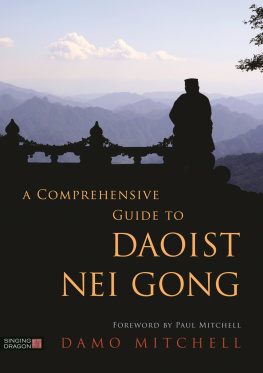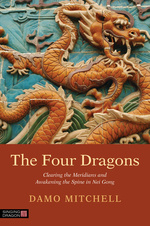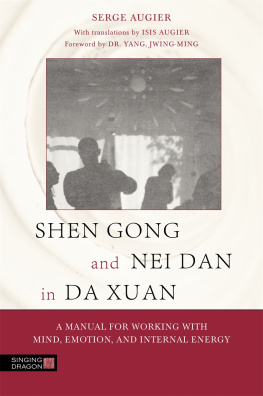Like all the ancient Daoist traditions, the art of classical Chinese medicine is one rooted in experiential learning. In Heavenly Streams , Damo Mitchell shares an inner method to access our meridians and points. It is a valuable guidebook for those interested in practicing with the subtle energies of their own bodies.
Master Zhongxian Wu, lifelong Daoist practitioner and author of books on Daoist traditions, including Vital Breath of the Dao and Heavenly Stems and Earthly Branches TianGan DiZhi Heavenly Streams not only provides a truly comprehensive introduction to Nei Gong and Chinese medicine from the point of view of Daoism but offers the reader an effective way to understand this information within themselves.
Nick Lowe, practitioner of Chinese Medicine and Daoist Qi Gong instructor Delivered with an informal familiarity that has already sparked so many imaginations at Damos course lectures across Europe and the United States, Heavenly Streams peels away Daoisms persistently obscure mystical dogma to put todays practitioners in touch with internal arts and the energetic realm.
Steve Galloway, Taiji teacher and owner of the Taiji Online website
by the same author
Daoist Nei Gong
The Philosophical Art of Change Damo Mitchell
Foreword by Dr Cindy Engel ISBN 978 1 84819 065 8
eISBN 978 0 85701 033 9
of related interest
Fire Dragon Meridian Qigong Essential NeiGong for Health and Spiritual Transformation Master Zhongxian Wu and Dr Karin Taylor Wu ISBN 978 1 84819 103 7
eISBN 978 0 85701 085 8
Chinese Shamanic Cosmic Orbit Qigong Esoteric Talismans, Mantras, and Mudras in Healing and Inner Cultivation Master Zhongxian Wu
ISBN 978 1 84819 056 6
eISBN 978 0 85701 059 9
Vital Breath of the Dao
Chinese Shamanic Tiger Qigong Laohu Gong Master Zhongxian Wu
Foreword by Chungliang Al Huang ISBN 978 1 84819 000 9
eISBN 978 0 8570 110 7
Warrior Guards the Mountain The Internal Martial Traditions of China, Japan and South East Asia Alex Kozma
ISBN 978 1 84819 124 2
eISBN 978 0 85701 101 5
Heavenly Streams Meridian Theory in Nei Gong Damo Mitchell
Foreword by Rob Aspell 
London and Philadelphia
First published in 2013
by Singing Dragon
an imprint of Jessica Kingsley Publishers
116 Pentonville Road
London N1 9JB, UK
and
400 Market Street, Suite 400
Philadelphia, PA 19106, USA
www.singingdragon.com
Copyright Damien Mitchell 2013
Foreword copyright Robert Aspell 2013
All rights reserved. No part of this publication may be reproduced in any material form (including photocopying or storing it in any medium by electronic means and whether or not transiently or incidentally to some other use of this publication) without the written permission of the copyright owner except in accordance with the provisions of the Copyright, Designs and Patents Act 1988 or under the terms of a licence issued by the Copyright Licensing Agency Ltd, Saffron House, 610 Kirby Street, London EC1N 8TS. Applications for the copyright owners written permission to reproduce any part of this publication should be addressed to the publisher.
Warning: The doing of an unauthorised act in relation to a copyright work may result in both a civil claim for damages and criminal prosecution.
Library of Congress Cataloging in Publication Data A CIP catalog record for this book is available from the Library of Congress British Library Cataloguing in Publication Data A CIP catalogue record for this book is available from the British Library ISBN 978 1 84819 116 7
eISBN 978 0 85701 092 6
Printed and bound in Great Britain
Contents
The Six External Pathogenic Factors, Fluctuations of Heaven
and Earth
List of Figures, Tables and Boxes
Foreword
Man imitates the laws of Earth, Earth imitates the laws of Heaven,
Heaven imitates the laws of Dao, Dao imitates the laws of nature (Zi Ran).
Laozi, Dao De Jing , Chapter 25
Before the arrival of modern medicine, there were many traditional healing systems throughout the world that people depended on in order to treat disease. Almost all civilisations had their own methods of self-healing, and many contained similar elements in relation to developing the bodys energetic system. One traditional system, which has lasted over the millennia, is that of the ancient Chinese and the art of Daoism. Rather than solely centring their efforts on how to treat disease, the Daoists focused on preserving health and promoting longevity. It was clear to them that good health was far easier to maintain than it was to restore. Through practice and experience, they found that this should be done through self-development, cultivation of the mind and spiritual awareness. The Daoists understood that we are as one with the nature that surrounds us a microcosm within a macrocosm. They would therefore study the laws of nature, and understand in nature the relationship between the various manifestations of Yin, Yang and the Wu Xing, and observe too how this same relationship occurs within ourselves. To me, this is reflected in Laozis quote above. Towards the end of my Chinese medicine degree, I started to realise the extent to which modern teachings of Chinese medicine were lacking in these vital aspects. I began searching for further elaboration on the fundamental theories of Chinese medicine, but often came to a dead end, or struggled to determine the larger meaning within the classic texts. It was through Damo Mitchell that I found much of what I was looking for in the way of a deeper understanding.
I first met Damo while in the final year of my Chinese medicine degree. It was his vast knowledge of the finer details that first caught my attention. We soon struck up a friendship, with classical Chinese thought always at the heart of our conversations. My knowledge of Chinese medicine was still fresh I was still learning. Damo seemed to have truly internalised what he knew about the Daoist arts, and was still eager to go deeper. I quickly realised that he hadnt just learnt about Chinese medicine and Daoist philosophy, he had experienced it, and he lived it.
I had only known Damo for a short time when he kindly invited me to accompany him on a visit to China I jumped at the opportunity. For me it was life changing. It shaped my future, and provided me with a whole new dimension to what Id previously learnt. I would say that we grew close over that month, and I got to know Damo for who he truly is. There arent many people of his age, or any age for that matter, with such genuine ability and understanding.
In Heavenly Streams , Damo continues his exploration into self-cultivation, and shares openly his understandings of the human energy system from both a Chinese medicine and a Daoist perspective. Many of the more spiritual and esoteric aspects of Chinese medicine have unfortunately been left out of institutional teachings over the years. Perhaps this is due to their more complex nature and the commitment needed to comprehend them, though ultimately they are at the heart and soul of classical Chinese thought. Damos own commitment to the internal arts is inspiring, and thanks to his understanding through experiential learning, Damo distils simple thoughts from complex thoughts developed over centuries. He delivers to us his knowledge of the Daoist self-cultivation that was once a major part of what we know of as Chinese medicine. Heavenly Streams expands on the fundamental theories of Chinese medicine, and is welcome in bridging the gap between todays teachings and the more spiritual and esoteric practices of classical Chinese thought that are so often hard to come by, providing you with the essence of what should be followed for personal basic (and more advanced) practices.
Next page





